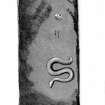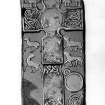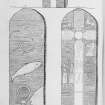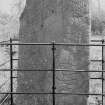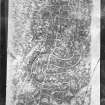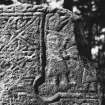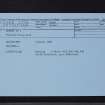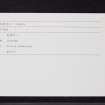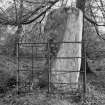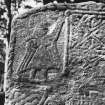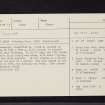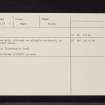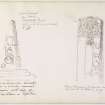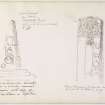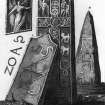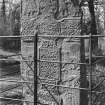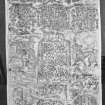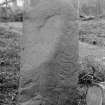Following the launch of trove.scot in February 2025 we are now planning the retiral of some of our webservices. Canmore will be switched off on 24th June 2025. Information about the closure can be found on the HES website: Retiral of HES web services | Historic Environment Scotland
Hunters Hill, Thornton Standing Stone
Cross Slab (Pictish), Pictish Symbol Stone (Pictish)
Site Name Hunters Hill, Thornton Standing Stone
Classification Cross Slab (Pictish), Pictish Symbol Stone (Pictish)
Alternative Name(s) Loanhead; Glamis No. 1; Hunter's Hill Standing Stone, Thornton
Canmore ID 32064
Site Number NO34NE 17
NGR NO 39379 46545
Datum OSGB36 - NGR
Permalink http://canmore.org.uk/site/32064
- Council Angus
- Parish Glamis
- Former Region Tayside
- Former District Angus
- Former County Angus
Glamis 1, Hunter’s Hill, Glamis, Angus, Pictish cross-slab
Measurements: H 1.52m +, W 0.71m, D 0.05m-0.15m
Stone type: sandstone
Place of discovery: NO 3937 4654
Present location: in situ on Hunter’s Hill within small iron railing enclosure in a plantation of trees.
Evidence for discovery: known from at least the early 18th century to be standing on the north slope of Hunter’s Hill. Location marked on the 1st edition 1 inch map (1843-1882), at which time there was no plantation.
Present condition: worn and top corner damaged.
Description
Roughly dressed to a slightly arched top, the slab is carved in low relief and incision on both sides. Face A bears an equal-armed cross with a central roundel and wide open rounded armpits, set on a shaft the base of which is below ground level. The cross is framed by a roll moulding and filled with interlace ornament, with key pattern in the roundel. Above the top of the side-arms the edge of the slab has a frame carved as a two-cord twist. To the left of the upper arm is a winged figure facing right, with double spirals at the joints of the double wings. To the right of the upper arm is an animal-headed figure in a tunic facing right towards a damaged but apparently smaller figure facing left, and the two appear to be grappling. Below the side-arms on the left is a seated deer with antlers facing left and below it the foreleg of another animal the rest of which is missing. On the right are two animals one above the other facing left, and a triple disc symbol above a flower symbol. On the irregular face C are traces of an incised animal facing right, above a deeply incised serpent.
Date range: seventh to ninth century.
References: Gordon 1726, 163: ECMS pt 3, 221, no 1; Fraser 2008, no 60.
Compiled by A Ritchie 2016
NO34NE 17 39379 46545
(NO 3937 4654) Standing Stone (NR) (Sculptured)
OS 6" map, (1959)
This cross-slab, classified as Class I, re-used in the Class II (9th - 10th century AD.) period, is located in a wood near Thornton. It is 5' high, and 2'4" broad. On one side is an interlaced cross, with human figures, animals and other symbols. On the reverse is a beast, a serpent and part of a mirror. The area around it was excavated in 1855, but nothing was found.
A Jervise 1859; J R Allen and J Anderson 1903; G B Mitchell 1935; I Henderson 1960; RCAHMS 1983
Field Visit (16 July 1969)
This cross slab, although now slightly weathered, is as described above.
Visited by OS (W D J) 16 December 1969.
Note (1983)
Hunter's Hill, Thornton NO 3937 4654 NO34NE 17
A Class II Pictish cross-slab, which stands to the E of Glamis in a forestry plantation on the N flank of Hunters Hill, about 350m WSW of Thornton. The cross is sculpted in relief, and incised on the back there are a beast, a serpent and a mirror.
RCAHMS 1983
(Gordon 1726, 163; Stuart 1856, 25-6, plate lxxxiii; Allen and Anderson 1903, iii, 221; Henderson 1958, 60; Coutts 1970, 62-3, no. 21).
Reference (1997)
Class II symbol stone - Glamis 1. On E face are a cross with an angel, two figures,two deer and two other unidentified animals. A triple disc above a flower are below these. On the reverse a beast above a serpent beside a mirror.
A Mack 1997
Laser Scanning (2 February 2012)
A high-resolution laser scan survey was undertaken of the Pictish symbol stone at Hunter's Hill, near Glamis, in February 2012. A solid mesh was produced, along with a series of visualisations of the carving.
Information from Oasis (aocarcha1-122647) 18 May 2012




























